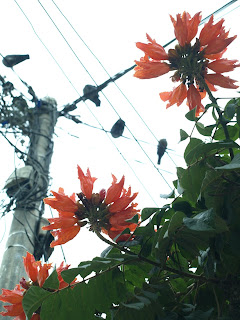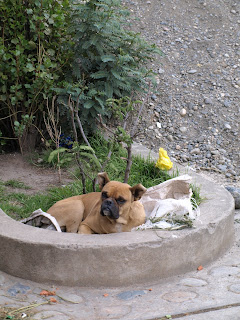People seem to have varying opinions on Lima, capital of Peru. Other travellers, like myself, tend to be in Lima only in transit, and the experience is that of a huge chaotic mess rushing along at high speed, with danger lurking at every corner. But all the people I have met who live there, discover the city's hidden gems, and have gradually grown to love it. My week in Lima was spent in the company of my friends Niko, Marianna and Sandra - people who know the city like the back of thier hand, and who showed me and my travelling companions Sabrina and Matthieu the real Lima....
One of the most dommiant aspects of the city is the traffic. There seems to be absolutely no order or logic to the everlasting flow of cars, taxis, combis and busses honking their way through the city - and as a pedestrian, you just have to be quick about it! No picture can quite describe it, but here are a few to give you an idea.
The city is located in the desert, on the shore of the Pacific ocean with its long, drawnout breakers that attracts surfers to the beach every day. There is quite a drop down to the sea, but all along the clifftop, parks and pathways allow you to enjoy the view. A lot of very posh housing is to be found aloung the coast, especially in the suburb of Miraflores, where one truly understands why Peru is the most unequal country in the world in terms of distrubution of wealth.
The rest of the city is made up of a number of different neighbourhoods, all in some stage of developement, so there is a real mix of tall modern flats, shooting up amongst beatifull old colonial houses of all colours. It is a real shame that there seems to be no recognition of the value of these picturesque areas, as the value of the plot of land exceeds that of the house itself. The tourists never go, so the town can not make a profit of the cultural value.
In the town center, we passed an exhibition that the council had put up, to show the differnt projects that the state had financed to renew the town. In many cases, the projects consisted of clearing slum towns and market areas, and replace them with roads and green lawns. The exibition consisted of a series of before and after pictures that we found hilarious, as the message to the citizens was not very subtle. There were also a number of models, we were especialy facsinated by the one of the slum town before it was destroyed - the detail is amazing!
In the midst of all this jumble, one stumbles every now and then on a Huaca, preinca tempels, built as huge adobe pyramids. These sites have been rather badly treated in the course of history, but are now being preserved and restored. These sites are typical of Lima, and I went to visit one with my friend Marianna. There, we also sumbled apon another curiosity - a Peruvian hairless dog. These are quite rare, and unique to the country, so of course they are very proud of them - but they certainly are not very pretty!

Preinca figures. The expresions, and the synthesis of detail in the pottery and textiles of this period are amazing.
One of the absolute highlights of this city, is the fact that it is the culinary Mecca of South America. The ingredients are so fresh, and of such high quality, that they can produce the most amazing food. One of the specialties is cebiche; fish and seafood marinated in lemon juice and chilies, mixed with raw onions, and served with sweet potato. Very filling, at Matthieu is about to discover!
Of course, Niko knows all the best places to eat in Lima, so we went to a place called the Blue Moon, owned by an old an from Sicily. It is a huge buffet, 80 different dishes every day, with lots of delicious imports from Italy, and the best seafood dishes I have ever had. It is is ridiculously cheap, our guess is that the owner is a fanatic gourmet, and he just loves sharing good food.... He has an impressive collection of bottles on display, 17500, it covers walls and ceilings, and it has taken him 27 years. Needles to say, we had to take the whole day off for this event, no good rushing through it, and you need to sleep it off afterwards!
I have really enjoyed my stay in Lima, and have met some fantastic people - no pictures of the nightscene in Lima, though I assure you, it is quite lively! Thank you Niko, Marianna, Sandra, and many others - I could not have wished for better guides, or friends....






































































